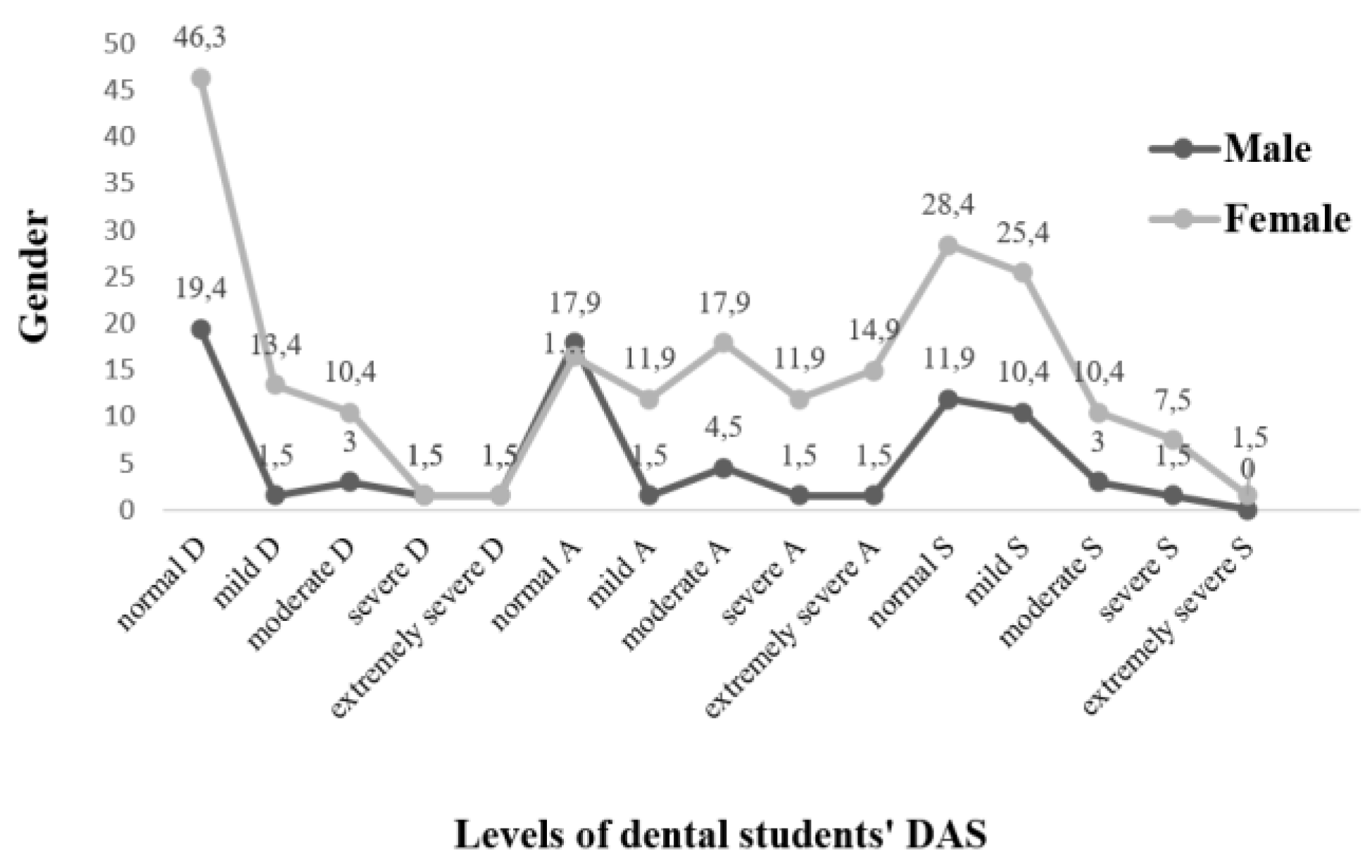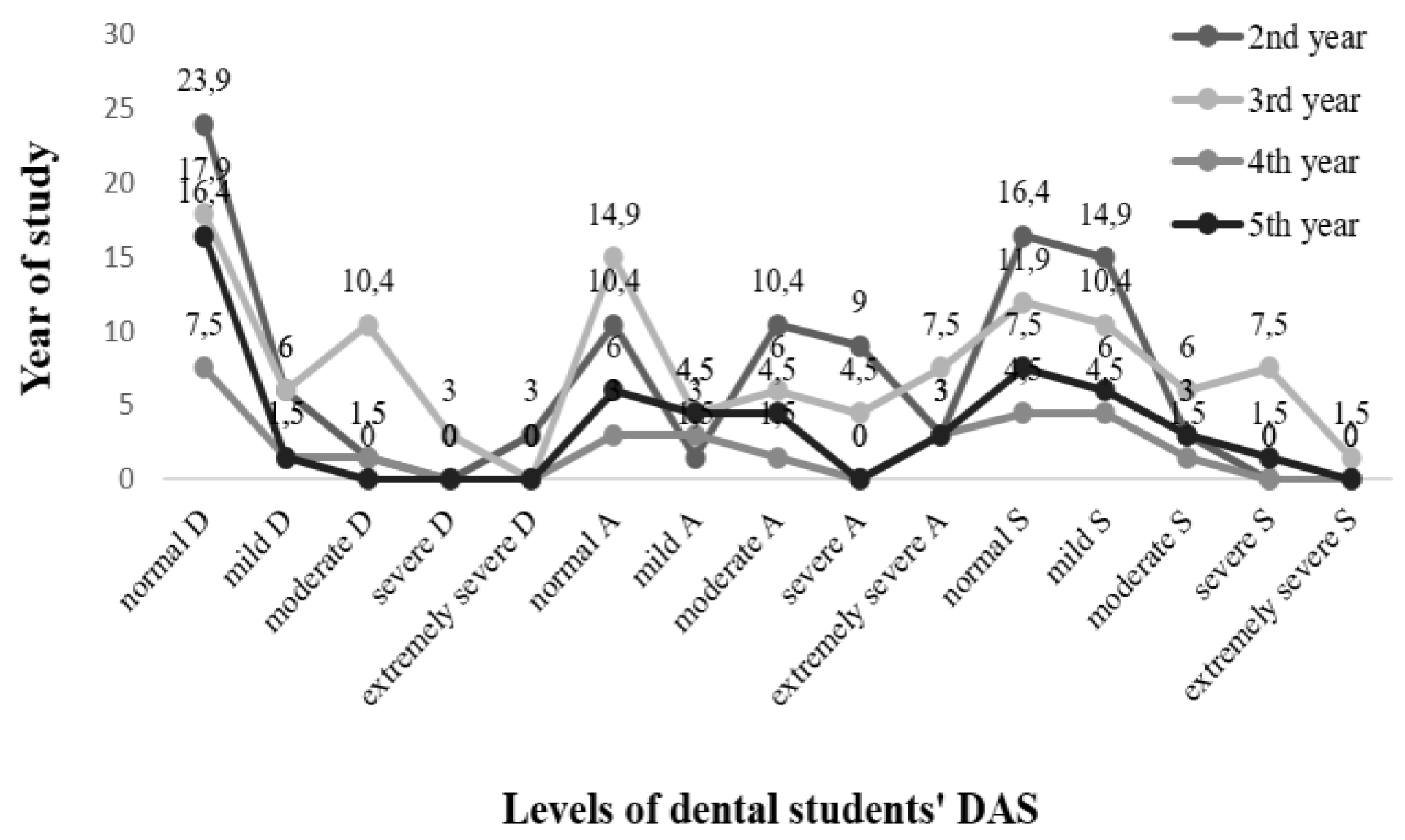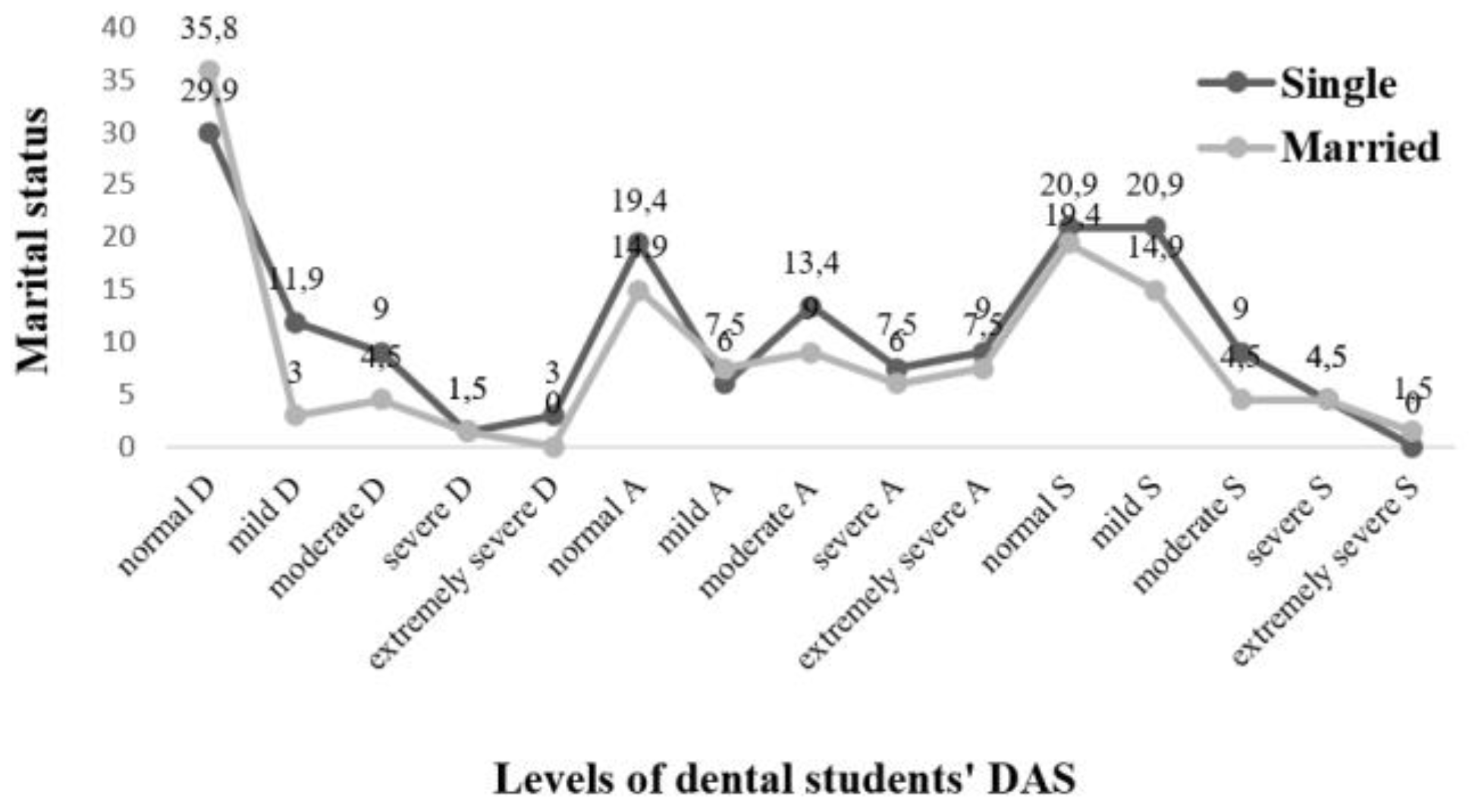Prevalence of Depression, Anxiety and Stress After the COVID-19 Pandemic Period Among Students at the Medical University of Sofia; Significance of Demographic, Educational, and Pandemic-Related Variables
Abstract
:Introduction
Materials and Methods
Results
Discussions
Conclusions
Compliance with ethical standards
Conflict of interest disclosure
References
- Stormon N, Ford PJ, Kisely S, Bartle E, Eley DS. Depression, anxiety and stress in a cohort of Australian dentistry students. Eur J Dent Educ. 2019, 23, 507–514. [Google Scholar] [CrossRef] [PubMed]
- Anwar N, Alshammary F, Siddiqui AA, Alenzi RH, Alshmmari BH, Alam MK. Level of anxiety and depression among undergraduate dental students of University of Hail, Saudi Arabia. Work. 2021, 70, 853–859. [Google Scholar] [CrossRef]
- Aboalshamat K, Al-Zaidi D, Jawa D, Al-Harbi H, Alharbi R, Al-Otaibi S. The effect of life coaching on psychological distress among dental students: interventional study. BMC Psychol. 2020, 8, 106. [Google Scholar] [CrossRef]
- Basudan S, Binanzan N, Alhassan A. Depression, anxiety and stress in dental students. Int J Med Educ. 2017, 8, 179–186. [Google Scholar] [CrossRef]
- Bathla M, Singh M, Kulhara P, Chandna S, Aneja J. Evaluation of anxiety, depression and suicidal intent in undergraduate dental students: A cross-sectional study. Contemp Clin Dent. 2015, 6, 215–222. [Google Scholar] [CrossRef]
- Barabari P, Moharamzadeh K. Novel Coronavirus (COVID-19) and Dentistry-A Comprehensive Review of Literature. Dent J (Basel). 2020, 8, 53. [Google Scholar] [CrossRef]
- Gambarini G, Di Nardo D, Obino FV, et al. Academic Dental Activities and COVID-19 Pandemic. J Contemp Dent Pract. 2020, 21, 598. [Google Scholar] [CrossRef]
- Gurgel BCV, Borges SB, Borges REA, Calderon PDS. COVID-19: Perspectives for the management of dental care and education. J Appl Oral Sci. 2020, 28, e20200358. [Google Scholar] [CrossRef]
- Hung M, Licari FW, Hon ES, et al. In an era of uncertainty: Impact of COVID-19 on dental education. J Dent Educ. 2021, 85, 148–156. [Google Scholar] [CrossRef]
- Loch C, Kuan IBJ, Elsalem L, Schwass D, Brunton PA, Jum’ah A. COVID-19 and dental clinical practice: Students and clinical staff perceptions of health risks and educational impact. J Dent Educ. 2021, 85, 44–52. [Google Scholar] [CrossRef]
- Agius AM, Gatt G, Vento Zahra E, et al. Self-reported dental student stressors and experiences during the COVID-19 pandemic. J Dent Educ. 2021, 85, 208–215. [Google Scholar] [CrossRef]
- Generali L, Iani C, Macaluso GM, Montebugnoli L, Siciliani G, Consolo U. The perceived impact of the COVID-19 pandemic on dental undergraduate students in the Italian region of Emilia-Romagna. Eur J Dent Educ. 2021, 25, 621–633. [Google Scholar] [CrossRef]
- Hakami Z, Khanagar SB, Vishwanathaiah S, et al. Psychological impact of the coronavirus disease 2019 (COVID-19) pandemic on dental students: A nationwide study. J Dent Educ. 2021, 85, 494–503. [Google Scholar] [CrossRef]
- Akinkugbe AA, Garcia DT, Smith CS, Brickhouse TH, Mosavel M. A descriptive pilot study of the immediate impacts of COVID-19 on dental and dental hygiene students’ readiness and wellness. J Dent Educ. 2021, 85, 401–410. [Google Scholar] [CrossRef]
- Chakraborty T, Subbiah GK, Damade Y. Psychological Distress during COVID-19 Lockdown among Dental Students and Practitioners in India: A Cross-Sectional Survey. Eur J Dent. 2020, 14, S70–S78. [Google Scholar] [CrossRef]
- Haridy R, Abdalla MA, Kaisarly D, Gezawi ME. A cross-sectional multicenter survey on the future of dental education in the era of COVID-19: Alternatives and implications. J Dent Educ. 2021, 85, 483–493. [Google Scholar] [CrossRef]
- Sukumar S, Dracopoulos SA, Martin FE. Dental education in the time of SARS-CoV-2. Eur J Dent Educ. 2021, 25, 325–331. [Google Scholar] [CrossRef]
- Kharma MY, Koussa B, Aldwaik A, et al. Assessment of Anxiety and Stress among Dental Students to Return to Training in Dental College in COVID-19 Era. Eur J Dent. 2020, 14, S86–S90. [Google Scholar] [CrossRef]
- Lovibond SH, Lovibond PH. Manual of the depression anxiety stress scales. 2nd ed. Sydney: Psychology Foundation of Australia; 1995.
- Henry JD, Crawford JR. The short-form version of the Depression Anxiety Stress Scales (DASS-21): construct validity and normative data in a large non- clinical sample. Br J Clin Psychol. 2005, 44, 227–239. [Google Scholar] [CrossRef]
- Ahad A, Chahar P, Haque E, Bey A, Jain M, Raja W. Factors affecting the prevalence of stress, anxiety, and depression in undergraduate Indian dental students. J Educ Health Promot. 2021, 10, 266. [Google Scholar] [CrossRef]
- Aboalshamat K, Hou XY, Strodl E. Psychological well- being status among medical and dental students in Makkah, Saudi Arabia: a cross-sectional study. Med Teach. 2015, 37, S75–S81. [Google Scholar] [CrossRef]
- Arrieta Vergara K, Cárdenas SD, Martínez FG. Síntomas de depresión, ansiedad y estrés en estudiantes de odontología: prevalencia y factores relacionados [Symptoms of Depression, Anxiety and Stress Among Dental Students: Prevalence and Related Factors]. Rev Colomb Psiquiatr. 2013, 42, 173–81. [Google Scholar] [CrossRef]
- Woon LS, Leong Bin Abdullah MFI, Sidi H, Mansor NS, Nik Jaafar NR. Depression, anxiety, and the COVID-19 pandemic: Severity of symptoms and associated factors among university students after the end of the movement lockdown. PLoS One. 2021, 16, e0252481. [Google Scholar] [CrossRef]
- Ghasemi M, Lotfollahzadeh H, Kermani-Ranjbar T, Kharazifard MJ. Effect of Music Practice on Anxiety and Depression of Iranian Dental Students. J Dent (Tehran). 2017, 14, 138–143. [Google Scholar]
- Khanagar SB, Al-Ehaideb A, Jamleh A, et al. Psychological Distress among Undergraduate Dental Students in Saudi Arabia and Its Coping Strategies-A Systematic Review. Healthcare (Basel). 2021, 9, 429. [Google Scholar] [CrossRef]
- Jowkar Z, Masoumi M, Mahmoodian H. Psychological Stress and Stressors Among Clinical Dental Students at Shiraz School of Dentistry, Iran. Adv Med Educ Pract. 2020, 11, 113–120. [Google Scholar] [CrossRef]
- Peker I, Alkurt MT, Usta MG, Turkbay T. The evaluation of perceived sources of stress and stress levels among Turkish dental students. Int Dent J. 2009, 59, 103–111. [Google Scholar]
- Sanders AE, Lushington K. Effect of perceived stress on student performance in dental school. J Dent Educ. 2002, 66, 75–81. [Google Scholar] [CrossRef]
- Gao W, Ping S, Liu X. Gender differences in depression, anxiety, and stress among college students: A longitudinal study from China. J Affect Disord. 2020, 263, 292–300. [Google Scholar] [CrossRef]
- Muirhead V, Locker D. Canadian dental students’ perceptions of stress. J Can Dent Assoc. 2007, 73, 323. [Google Scholar]
- Waqas A, Rehman A, Malik A, Muhammad U, Khan S, Mahmood N. Association of Ego Defense Mechanisms with Academic Performance, Anxiety and Depression in Medical Students: A Mixed Methods Study. Cureus. 2015, 7, e337. [Google Scholar] [CrossRef]
- Avramova, NT. Dental fear, anxiety, and phobia; causes, diagnostic criteria and the medical and social impact. J Mind Med Sci. 2022, 9, 202–208. [Google Scholar] [CrossRef]
- Avramova N, Mihaylova I, Yaneva-Ribagina K, Bonev B, Nenov S. Dental students’ perspectives on the implementation and effectiveness of online learning due to COVID-19 pandemic: a descriptive cross- sectional study in Bulgaria. Advanced Education. 2021, 18, 109–118. [Google Scholar] [CrossRef]



| Demographic variable | No. | % |
|---|---|---|
| Gender | ||
| Male | 18 | 26.9 |
| Female | 49 | 73.1 |
| Year of study | ||
| 2nd year | 23 | 34.3 |
| 3rd year | 25 | 37.3 |
| 4th year | 7 | 10.4 |
| 5th year | 12 | 17.9 |
| Marital status | ||
| Single | 37 | 55.2 |
| Married /with a partner | 30 | 44.8 |
| Grade Point Average (GPA) of previous year | ||
| 5.50 – 6.00 | 12 | 17.9 |
| 4.50 - < 5.50 | 28 | 41.8 |
| 3.50 - < 4.50 | 24 | 35.8 |
| 3.00 - < 3.50 | 3 | 4.5 |
| Dentistry 1st choice | ||
| Yes | 63 | 94.0 |
| No | 4 | 6.0 |
| Financial problems | ||
| Yes | 1 | 1.5 |
| No | 49 | 73.1 |
| Sometimes | 17 | 25.4 |
| Do you think that restrictions on in- person training related to COVID- 19 pandemic have negatively affected your education? | ||
| Only in terms of my practical training | 26 | 38.8 |
| In theoretical disciplines only | 2 | 3.0 |
| In all disciplines | 28 | 41.8 |
| I don't think there are any negative consequences for my training | 11 | 16.4 |
| Level | Depression N (%) | Anxiety N (%) | Stress N (%) |
|---|---|---|---|
| Normal | 44 (65.7) | 23 (34.3) | 27 (40.3) |
| Mild | 10 (14.9) | 9 (13.4) | 24 (35.8) |
| Moderate | 9 (13.4) | 15 (22.4) | 9 (13.4) |
| Severe | 2 (3.0) | 9 (13.4) | 6 (9.0) |
| Extremely severe | 2 (3.0) | 11 (16.4) | 1 (1.5) |
| Variables | D | A | S |
|---|---|---|---|
| Gender* | .725 | .003 | .471 |
| Marital status* | .037 | .979 | .815 |
| GPA** | .492 | .894 | .713 |
| Dentistry 1st choice* | .808 | .848 | .750 |
| Financial problems** | .228 | .502 | .254 |
| COVID-19** | .500 | .791 | .680 |
| DAS categ. | Year of study* (Sample 1 - Sample 2) | ||||||
|---|---|---|---|---|---|---|---|
| 2nd year 3rd year | 2nd year 4th year | 2nd year 5th year | 3rd year 4th year | 3rd year 5th year | 4th year 5th year | Sig.** | |
| D | .101 | .884 | .179 | .209 | .007 | .873 | .048 |
| A | .513 | .140 | .694 | .205 | .281 | .392 | .906 |
| S | .035 | .782 | .454 | .254 | .331 | .757 | .198 |
Disclaimer/Publisher’s Note: The statements, opinions and data contained in all publications are solely those of the individual author(s) and contributor(s) and not of MDPI and/or the editor(s). MDPI and/or the editor(s) disclaim responsibility for any injury to people or property resulting from any ideas, methods, instructions or products referred to in the content. |
Share and Cite
Avramova, N.T. Prevalence of Depression, Anxiety and Stress After the COVID-19 Pandemic Period Among Students at the Medical University of Sofia; Significance of Demographic, Educational, and Pandemic-Related Variables. J. Mind Med. Sci. 2023, 10, 260-266. https://doi.org/10.22543/2392-7674.1376
Avramova NT. Prevalence of Depression, Anxiety and Stress After the COVID-19 Pandemic Period Among Students at the Medical University of Sofia; Significance of Demographic, Educational, and Pandemic-Related Variables. Journal of Mind and Medical Sciences. 2023; 10(2):260-266. https://doi.org/10.22543/2392-7674.1376
Chicago/Turabian StyleAvramova, Nadya T. 2023. "Prevalence of Depression, Anxiety and Stress After the COVID-19 Pandemic Period Among Students at the Medical University of Sofia; Significance of Demographic, Educational, and Pandemic-Related Variables" Journal of Mind and Medical Sciences 10, no. 2: 260-266. https://doi.org/10.22543/2392-7674.1376
APA StyleAvramova, N. T. (2023). Prevalence of Depression, Anxiety and Stress After the COVID-19 Pandemic Period Among Students at the Medical University of Sofia; Significance of Demographic, Educational, and Pandemic-Related Variables. Journal of Mind and Medical Sciences, 10(2), 260-266. https://doi.org/10.22543/2392-7674.1376



